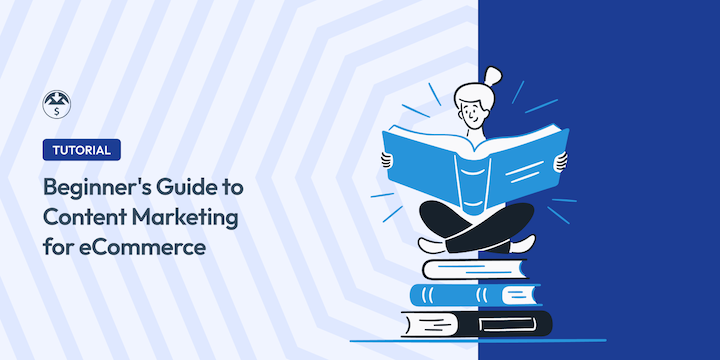
Do you want to learn how to leverage content marketing for your online business? The right eCommerce content marketing strategy can help attract and retain customers.
By creating and sharing valuable, relevant, and consistent content, you can build trust and credibility with your target audience, establish yourself as a thought leader in your industry, and drive traffic to your eCommerce store.
Plus, with the right tools and tips, it’s simple!
🔎 In this article, I’ll cover:
- What Is Content Marketing?
- Why Use Content Marketing for eCommerce
- How to Use Content Marketing for eCommerce
- 1. Define Your Goals & Objectives
- 2. Identify Your Target Audience
- 3. Conduct Competitor Research
- 4. Develop Your Content Marketing Strategy
- 5. Choose the Right Content Formats
- 6. Focus on High-Quality Content Creation
- 7. Optimize for Search Engines & User Experience
- 8. Leverage User-Generated Content & Social Proof
- 9. Promote Your Content
- 10. Measure & Optimize Content Marketing Campaigns
- FAQs on eCommerce Content Marketing
What Is Content Marketing?
Content marketing is the powerful strategy of creating and sharing valuable, relevant, and consistent content. The overall purpose is to produce content that attracts, educates, and ultimately converts your target audience into loyal customers.
For eCommerce, content marketing is about using content to showcase your products, build trust, and establish yourself as an authority and thought leader in your niche.
Content marketing is an increasingly popular and effective approach adopted by marketers, eCommerce brands, and business owners across industries worldwide.
According to Statista, 80% of global marketers consider their content strategy ‘very successful’. In addition, a Content Marketing Institute (CMI) report found that more than 60% of respondents said content marketing helped increase sales and revenue over the last year, up from 48% in 2022.
Why Use Content Marketing for eCommerce
Imagine a world where potential customers have no idea your amazing products exist. Content marketing helps bridge that gap.
According to a CMI study, companies that publish blogs receive 97% more inbound links than those that don’t. This statistic alone highlights the importance of content marketing for eCommerce businesses, as inbound links are a key factor in improving website visibility and organic traffic.
Content marketing is an ongoing process, and it takes time and effort to build a successful content marketing strategy. However, the rewards can be significant.
It’s crucial for your eCommerce success because it:
- Cuts through the noise of the saturated online market and grabs attention.
- Builds trust and credibility with potential customers.
- Improves Search Engine Optimization (SEO) to increase your website’s ranking in search results, leading to more organic traffic.
- Boosts customer engagement and keeps visitors coming back for more, fostering long-term relationships and building brand loyalty.
- Generates leads by providing potential customers with helpful and interesting information.
- Drives sales and conversions by nudging potential customers toward that coveted “buy now” button.
Overall, eCommerce content marketing is both an effective and cost-efficient way to drive business growth, attract qualified leads, and build strong relationships with your customers.
Types of eCommerce Content Marketing
Exploring some eCommerce content marketing examples can help you brainstorm ideas and use cases for your own content.
There are so many different ways eCommerce companies create and incorporate engaging content into their digital marketing strategies.
Let’s look at some of the most popular types of content and use cases for eCommerce.
Product Descriptions
When it comes to online selling, product pages and descriptions are essential. It’s important to craft compelling product descriptions that highlight features and benefits, address customer pain points, and incorporate relevant keywords.
Website content should be easy to scan, read, and digest. Not only does this mean formatting and designing your page content in a visually appealing way, but using language that is both powerful and simple to understand.
Visual Content (Images & Videos)
High-quality product photos are a must for any eCommerce site. When shoppers can’t physically touch your products, it’s important to make sure you give them as much visual information as possible. Infographics also provide an excellent solution for organizing a lot of data and information in an aesthetically pleasing way.
It’s also smart to use video content to showcase product features, offer tutorials and demonstrations, and even highlight customer testimonials. Videos are a powerful storytelling tool that can help you connect with your audience on a personal level.
Blog Posts
Blog posts are among the most popular types of content. They’re easy to create and incredibly versatile. Use them to share valuable insights, answer common customer questions, and establish yourself as an expert. Think “How-to” guides, trend reports, and industry news.
WordPress’ built-in blogging functionality makes creating educational and informational content throughout the customer journey a breeze.
Guides & Tutorials
Another common use case for content marketing is to offer in-depth guides and tutorials that help your audience get the most out of your products or solve related problems.
This could be in a concise, step-by-step instructional format via a blog post, a downloadable resource like a PDF, or something more long-form, comprehensive, and interactive, like an online course or eBook.
Email & Social Media Content
Share captivating social media posts and stories on social media platforms like Facebook, Instagram, and Twitter. Promote new products, offer sneak peeks, and run interactive contests.
Host live streams for Q&A sessions, product demonstrations, or behind-the-scenes glimpses to connect with your audience in real time.
Email newsletters are also an excellent way to promote pieces of content as well as communicate with your audience and consistently provide them with informative, engaging, and relevant updates and promotions.
How to Use Content Marketing for eCommerce
Now that we’ve covered the basics of eCommerce content marketing, it’s time to get into some key tips and best practices. Below are some of the best ways to use content marketing for eCommerce brands.
Later in the post, I’ll cover some of the best tools to use to implement some of the following tips. and strategies.
1. Define Your Goals & Objectives
As with any marketing initiative, it’s important to start with a clear idea of what your goals are. What do you want to achieve with your content marketing efforts?
Without well-defined goals, it can be difficult to create content that resonates with your target audience and drives business results.
Content marketing goals should align with the overall business objectives of the eCommerce store. Whether it’s increasing brand awareness, generating leads, or driving sales, having specific goals ensures that the content strategy is focused on achieving tangible results.
Plus, defining goals helps prioritize content creation tasks and allocate resources effectively. It allows you to determine which content formats, channels, and topics will yield the best results.
When starting, I recommend setting SMART goals—make sure your goals are specific, measurable, achievable, relevant, and time-bound.
Setting specific goals (e.g., increasing website traffic by 20% in 3 months) provides a benchmark against which success can be measured. Tracking key metrics like conversion rates helps you evaluate the effectiveness of your content strategy and make necessary adjustments.
2. Identify Your Target Audience
Understanding our target audience is crucial for a successful eCommerce content strategy.
The CMI research study mentioned earlier found that over 60% of marketers find choosing the right content for their audience challenging. However, 81% of the top performers attribute content marketing success to understanding their audience.
Who are you trying to reach? What are their needs, challenges, and interests? Conduct market research and buyer personas to gain a deep understanding.
By knowing your target audience, you can create content that is personalized and relevant to the pain points of specific customer segments.
3. Conduct Competitor Research
Researching your competitors is crucial in content marketing for eCommerce. It provides valuable insights into their strategies, content performance, and customer engagement.
Understanding your competitors allows you to uncover content gaps—topics or areas that your competitors are not covering with their content.
This presents an opportunity for you to find a unique selling proposition (USP) and use your content to highlight how you stand out.
Additionally, competitor research can help you identify successful content formats, keywords, and marketing channels to develop a more effective content marketing strategy.
There are a handful of competitor and market research tools available. SEMrush and Ahrefs are popular options:
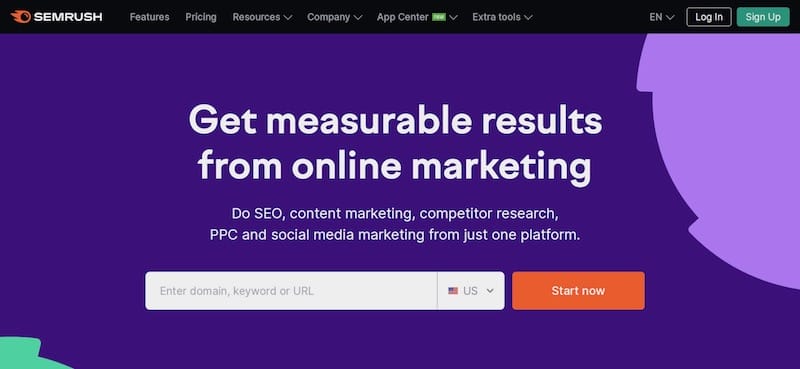
They provide insights into your competitors’ organic and paid search traffic, backlinks, keyword research, and content performance.
BuzzSumo is also worth checking out.
This tool helps you discover popular content and influencers in your industry. It’s a great way to identify content and messaging that resonates with your target audience.
4. Develop Your Content Marketing Strategy
Once you understand your audience, goals, and competitive landscape, develop a content marketing strategy that outlines the types of content you’ll create, the channels you’ll use, and your content publishing schedule.
Your eCommerce content marketing plan will likely change over time. Not only will you want to adjust your approach as your business grows, but consumer preferences and online eCommerce trends are constantly evolving. Staying informed about these changes and adapting your content marketing strategy is necessary.
It’s also smart to plan and organize your content in advance with a content calendar. This helps you stay organized and ensures a consistent flow of fresh, great content.
5. Choose the Right Content Formats
‘Content format’ refers to the specific medium or structure in which you present your content to your target audience (video, article, podcast, promotional email, etc.).
Different content formats cater to different preferences and consumption habits. Blog posts are great for in-depth information, infographics for quick visual takeaways, and videos for demonstrations and storytelling. Choose formats that resonate with your audience and content goals.
Some formats, like infographics, are more shareable than others. Shareable content can extend your reach and increase brand exposure through social media and other channels. Other formats, such as email marketing campaigns, are better suited for driving conversions.
By diversifying your content formats, you can appeal to a wider audience and increase engagement. Be sure to tailor your content for each platform. For example, keep Instagram captions concise and visually engaging, while blog posts can be longer and more in-depth.
Search engines like Google consider the format of your content when ranking it in search results. Therefore, optimizing your content for specific formats can improve your visibility and organic traffic.
6. Focus on High-Quality Content Creation
Your content is a reflection of your eCommerce brand. High-quality content establishes you as an authority, builds trust, and keeps visitors engaged.
There are a few tips you can use to ensure you create high-quality content. One is to make sure it’s engaging and visually appealing.
Use images, infographics, and videos to break up text, add visual interest, and enhance understanding. Structure content for readability with clear headings, subheadings, bullet points, and short paragraphs.
If you don’t have much writing or design experience, there are plenty of tools available to help.
Design tools like Canva are great for creating visually appealing graphics and social media posts, even if you’re not a design pro:
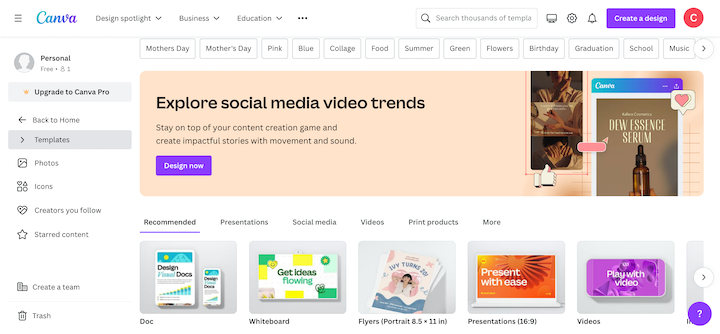
Canva provides templates and other design elements available for a wide range of content formats.
When it comes to writing the content, tools like Grammarly are helpful because they check for grammatical errors and suggest improvements, resulting in a more polished and professional piece of content.
Additionally, you might consider AI content generators, such as Gemini, ChatGPT, or Copy.ai.
While these automated tools won’t give you flawless content for your eCommerce site, they can be useful as a starting point. In fact, the Content Marketing Institute found that nearly 80% of technology marketers use generative AI for content-related tasks.
7. Optimize for Search Engines & User Experience
SEO is crucial for getting your content seen by the right people. It helps you rank higher in search results, leading to more organic search traffic to your WordPress site.
Start with keyword research. Identify relevant keywords that your target audience is searching for. Tools like Ahrefs, SEMrush, and Google Keyword Planner can help:
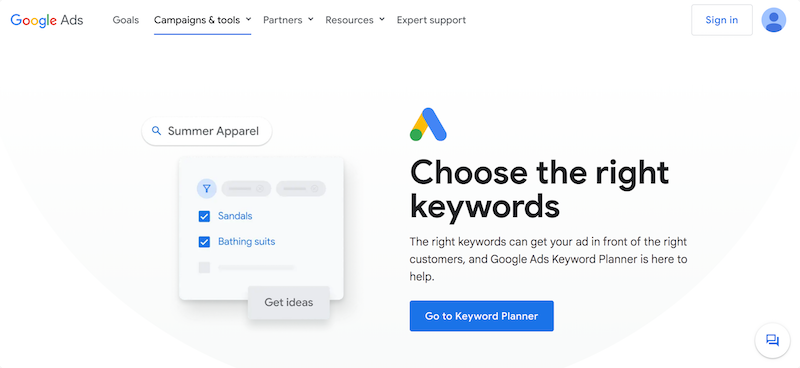
Integrate your target keywords naturally throughout your content, but avoid keyword stuffing.
Make sure you’re optimizing content for both search engines and your users. If you’re genuinely focused on providing helpful and useful content to your readers, your site rankings will likely reflect that.
Include compelling meta descriptions and titles that accurately reflect your content and entice users to click. Internal linking—linking to relevant content on your website—can also improve both the user experience and SEO.
The best SEO tip for eCommerce content marketing that I can offer is to install All In One SEO (AIOSEO):
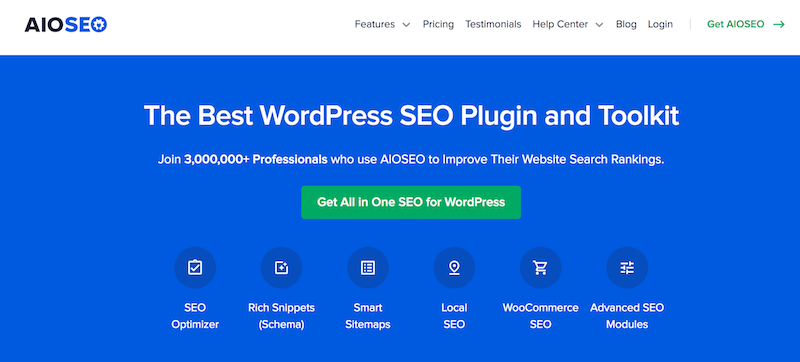
AIOSEO is an excellent, robust SEO WordPress plugin that helps automate the process of optimizing your eCommerce content. It simplifies on-page optimization and provides actionable recommendations for improving the content for reliability and other SEO factors.
🔎 Learn more about eCommerce SEO
8. Leverage User-Generated Content & Social Proof
Content marketing is about building trust and relationships with your audience. Two strategies to implement that help facilitate and foster those are User-Generated Content (UGC) and social proof.
UGC is created by your audience, such as product reviews, customer testimonials, and social media posts featuring your products:
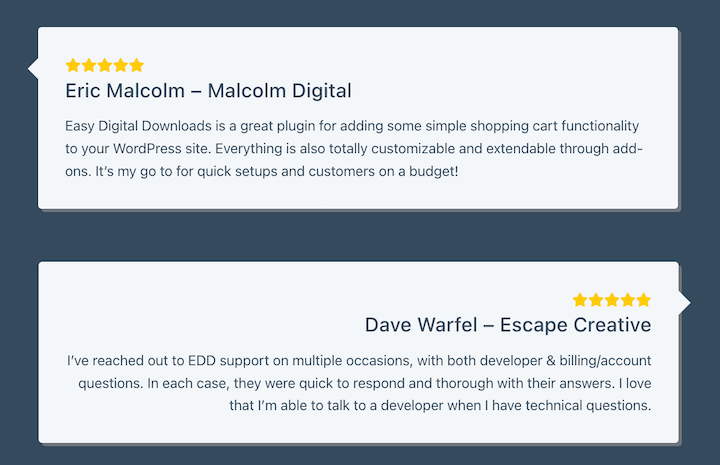
Social proof demonstrates the value of your offerings, helping boost your trustworthiness and credibility. It leverages the positive experiences of others to persuade shoppers to act (case studies, success stories, etc.).
Encourage customers to leave reviews on your website and social media platforms. Easy Digital Downloads Reviews add-on lets you easily collect and display customer reviews and ratings on your product pages.
TrustPulse is the best WordPress social proof plugin:

Use it to display customer activity notifications on your website, such as every time a customer makes a purchase.
To encourage more UGC, consider running contests and giveaways.
Entice visitors to share photos with your products, engage with your social media channels, etc., for added entries in the contest.
9. Promote Your Content
Promoting your content is a crucial part of eCommerce content marketing. It helps you reach a wider audience and achieve your business goals. Without promotion, your content may not be seen by the people who need it most, and your efforts may go to waste.
There are several ways to promote your content. The best approach will vary depending on your specific goals and target audience. Some common strategies include:
- Social media marketing: Sharing your content on social media platforms is a great way to reach a large audience quickly and easily.
- Email marketing: Building an email list and sending engaging newsletters, promotional offers, and personalized emails helps nurture leads and drive sales. Easy Digital Downloads integrates with popular email marketing services like MailChimp and GetResponse for streamlined automation.
- Affiliate marketing & influencer partnerships: Partner with other businesses in your eCommerce niche to promote each other’s products and expand your reach. Partnering with influencers and industry experts can expose your brand to a wider audience and leverage your credibility.
Easy Digital Downloads offers valuable features to empower your content marketing strategy:
- EDD Free Downloads: Offer valuable downloadable resources like eBooks, whitepapers, and cheat sheets as lead magnets in exchange for email addresses.
- Discount codes & promotions: Create targeted discount codes to incentivize content engagement and purchases.
I also recommend using OptinMonster:
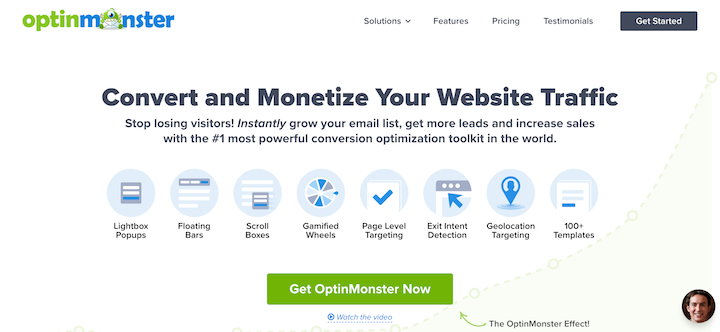
This lead generation plugin allows you to create targeted opt-in forms and capture valuable customer information. It’s perfect for conversion optimization elements to your site to promote your content and products.
10. Measure & Optimize Content Marketing Campaigns
The more you develop and analyze your content marketing campaigns, the easier it becomes to establish the best marketing tactics for your specific business needs and goals.
Consistently monitoring your performance helps you identify the most effective strategies for capturing the attention of potential buyers and turning them into new customers.
Data is your friend in content marketing!
To easily track your progress and optimize your strategy for better results, use MonsterInsights to integrate Google Analytics with your eCommerce website:
Track key metrics like website traffic, bounce rate, conversion rate, and time on site using Google Analytics. MonsterInsights also integrates seamlessly with Easy Digital Downloads and WooCommerce.
I recommend pairing MonsterInsights with EDD’s Advanced Reports feature. This combination will give you detailed insights into the buyer’s journey and help you better understand key factors and metrics influencing the performance of your online store, including specific products and content campaigns.
You can also use A/B testing to analyze different headlines, calls to action, and content formats to see what resonates best with your audience.
Don’t be afraid to experiment. Try different content formats, channels, and promotion strategies to see what works best for you.
FAQs on eCommerce Content Marketing
Let’s wrap up with some frequently asked questions about eCommerce and content marketing.
What content marketing strategies work best for eCommerce?
Ecommerce businesses can leverage a variety of content to connect with potential customers. High-performing content educates shoppers throughout their buying journey.
Informative blog posts or infographics addressing industry topics build awareness, while product reviews and comparisons guide consideration. User-generated reviews and video demonstrations showcasing product benefits can influence buying decisions.
Ultimately, the best content combines valuable information with engaging formats. Ecommerce businesses that create high-quality content tailored to each stage of the buyer journey will be well-positioned to attract, educate, and convert customers.
How often should I publish content?
Consistency is key! Aim for a regular publishing schedule, whether it’s daily, weekly, or bi-weekly.
Start small and scale up as you get comfortable. Repurpose existing content into different formats (e.g., blog post into infographic). Utilize free content creation tools like Canva.
How can I measure the ROI of my eCommerce content marketing?
Track key metrics like website traffic, conversion rates, and sales using website analytics tools like Google Analytics and EDD’s built-in sales reports.
Use EDD for eCommerce Content Marketing
By leveraging these tips, tools, and the power of Easy Digital Downloads, you can transform your online store into a content marketing powerhouse.
Remember, content marketing is a marathon, not a sprint. Stay consistent, be patient, and track your results. As you refine your strategy and learn what resonates with your audience, you’ll see your content marketing efforts blossom into increased brand awareness, website traffic, and ultimately, sales!
Don’t have Easy Digital Downloads yet? Grab your pass & get started in no time:
What’s next? Learn how to use consumer psychology in eCommerce to drive sales!
📣 P.S. Be sure to subscribe to our newsletter and follow us on Facebook or Twitter for more WordPress resources!
Using WordPress and want to get Easy Digital Downloads for free?
Enter the URL to your WordPress website to install.
Disclosure: Our content is reader-supported. This means if you click on some of our links, then we may earn a commission. We only recommend products that we believe will add value to our readers.